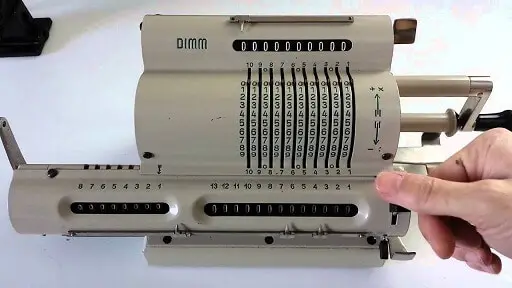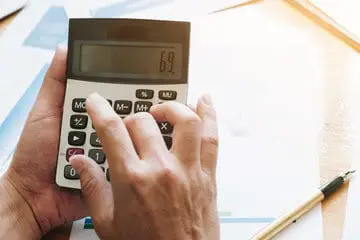Even if you are not a professional mathematician, most people end up needing to do some mathematical calculations from time to time. Doing math on a piece of paper may not only be time-consuming, but it could also be impossible at times.
That’s why it is a good idea to have a calculator handy whenever you need to solve a math problem. However, one possible issue with this is that there are an overwhelming number of options out there.
In general, there are eight types of calculators that each serve different purposes. Depending on your calculating needs, you might need a simple calculator for basic equations or a more advanced calculator that can display graphs of your results. The eight different types of calculators available today are:
- Basic Calculator
- Scientific Calculator
- Graphing Calculator
- Printing Calculator
- Online Calculator
- Abacus
- Mechanical Calculator
- Calculator Watch
We will go over all eight most common types of calculators and how they are most commonly used so you can decide which is best for you based on your needs. Whether you are simply adding numbers or performing advanced calculus, you will be able to find your perfect calculator, so keep on reading.
Types of Calculators
In the world today, there’s a wide range of calculators available for purchase. There are several well-known and even more not well-known calculator brands, each with a multitude of different types and models. It can be overwhelming to have to decide on one to purchase for your everyday use.
The type of calculator that you need largely depends on how you plan to use it If you simply want to add, subtract, multiply, and divide, you will need a much different calculator than someone who performs complicated functions and equations each day.
Below we will go over the most common calculator types starting with the simplest and progressing to more advanced and unique types. Once you identify your calculating needs, you will be able to decide which type of calculator you need.
Any of the calculators we will discuss can be purchased online or at an office supply store.

The simplest type of calculator available is in the “basic” category. These calculators are small and simple. They offer the basic quick arithmetic calculations of:
- Add
- Subtract
- Multiply
- Divide
These types of calculators generally don’t have functionality for complicated equations involving trigonometry or geometry.
A basic calculator will usually have one line on the screen. At any one time, you will be able to see either the equation you are typing in or the resulting answer, but not both at the same time due to limited screen space.
Basic calculators usually don’t have memory storage either, so you will not be able to review past calculations or see how you arrived at the number on your screen.
The basic calculator is great for anyone needing to perform quick calculations.
It is the perfect calculator to keep at home when you need to add a score for a game you are playing or convert measurements in the kitchen. This calculator is not ideal for calculating a list of figures unless you have time to double-check your calculations carefully.
These calculators can be found as a stand-alone item but are typically found within technology that we use every day. Most personal computers, smartphones, and smartwatches nowadays have basic calculators built into them or apps that can be downloaded.

A scientific calculator is one step up from a basic calculator. This calculator is what most elementary and middle school students must have for school since it is an inexpensive purchase with all of the functionality needed until calculus.
Scientific calculators have buttons for the basic mathematical functions in addition to buttons for advanced equations. These buttons are usually used to input and calculate complex equations that go beyond the simple add, subtract, multiply, and divide functions. These calculators typically have buttons for:
- Parenthesis
- Squaring and square root
- Logarithms
- Sine, Cosine, and Tangent
These buttons allow you to calculate more complex equations that are used to solve geometry or trigonometry questions. In these subjects, you will be calculating equations related to shapes and complex functions. This type of calculator is useful for anyone in classes or professionals working with:
- Algebra
- Geometry
- Trigonometry
- Statistics
- Pre-Calculus
Scientific calculators are used by most students and professionals and are pretty easy to find. This type of calculator can also be found pre-loaded on nearly every computer or smartphone. Sometimes, the basic calculator will be shown first with an option to switch to a scientific calculator.

A graphing calculator is one of the most advanced types of calculators.
These calculators are usually required for more advanced math classes like calculus. Looking at a graphing calculator, the biggest difference from the others is that it will have a large screen. This space is used to show the graphs and charts results for the equations that you are solving.
With many of the same buttons and functions as scientific calculators, the major benefits of a graphing calculator are:
- Graphing and charting capabilities
- Quick performance in high-level math equations with a strong computing component
- Better understanding of trigonometry and statistics with a visual component
- Memory storage
Graphing calculators are amazing machines that can take your mathematics to the next level.
However, they are only really needed by students in high-level math courses, engineers, scientists, and other professionals doing complicated math in their work. In this case, it does help to be a rocket scientist. You do not need this kind of calculator around the house for basic calculations.
A Word of Caution and a Tip About this Calculator
If you plan to use a graphing calculator in a class, be sure the classroom’s calculator policies allow this for examinations, especially large, standardized tests. With their improved functionalities, some test-makers believe that graphing calculators allow students to cheat and ban them.
Even if the graphing calculators are allowed in your testing facility, you will likely be asked to delete the device’s memory to make sure there is no cheating.
If you have a graphing calculator, you may not realize that you can play games on it. Graphing calculators are not gaming consoles, but they do have the functionality to play some basic games.
Some examples of basic games available on the graphing calculators include:
- Tetris
- PacMan
- Mario

A printing calculator is one that you will only need if you work in certain professions. This model was used more frequently before the prevalence and accessibility of phones and other advanced calculators. A printing calculator is different from the rest in that it prints everything that was typed into it.
Since these calculators have built-in printing capabilities, they are pretty bulky. Rather than being a handheld calculator like those we have discussed so far, these calculators are considered to be desktop tools.
Before the prevalence of online and advanced calculators with a lot of memory storage, these calculators were useful for checking work. Anyone doing math would use a printing calculator so that they could check their work and make sure there were no mistakes or typing errors when entering the equations.
Today, these types of calculators are mostly used by professionals working in accounting or payroll.
These are again used to make sure all financial calculations are accurate. You won’t usually find printing calculators in someone’s home. Rather, these are found in offices.
5. Online Calculator

Finally, there are also online calculators. These do not refer to a basic or scientific calculator that you can find online but instead are calculators made for specific purposes.
For example, there are online calculators to help you calculate:
- Mortgage payments
- Retirement saving needs
- Calories needed according to your BMI
Online calculators are generally programmed with certain formulas that are calculated when the user provides specific inputs. For example, an online retirement calculator might ask the user to input their age, current retirement savings, and annual salary.
With that information, the online calculator will be able to provide a result of how much money they should save by the time they retire. Other online calculators exist for:
- Exchanging currencies
- Converting between metric and imperial units
- Finding out how many days are between two dates
These calculators need fewer inputs than the others mentioned and will quickly apply the formula needed to get your answer.
Online calculators can be found for many purposes. This type of calculator is great for people who want a quick answer to their questions without needing to find and calculate formulas.
Another benefit of these calculators is that there are online calculators for nearly every purpose. If you need a calculation, someone has likely created an online calculator that can help.
Calculators Made With Older Technology
While the five most common types of calculators cover most of the calculators on the market, there are a few other less common types. These used to be more mainstream, but with advancing technologies, most people prefer newer calculators with a better source of power.
These calculators use older technologies, usually relying on physical and mechanical components, and have been around for generations. Even though there are more powerful calculators on the market, it is good to know the history of calculators to understand how they work.
6. Abacus

The abacus was the first calculator and has been used since ancient times. Some people, mostly in eastern countries, still use the abacus today. The abacus is also useful for blind people, as it is a physical counter and can be read by being felt with hands.
The abacus uses a series of stones or beads strung on a thin piece of circular wood. The stones or beads can be moved along the wood to track counting. While an abacus is a simple calculator, it is the oldest and serves as the basis on which newer calculators were designed and built.
7. Mechanical Calculator

Following the abacus, the first mechanical calculator was built in the 1600s. These calculators used wheels and gears to add, subtract, multiply, and divide.
Mechanical calculators have developed and changed over time. The “adding machine” was a popular type of mechanical calculator that was often found in offices until around the 1970s. In fact, mechanical calculators were used for hundreds of years before the modern electronic calculator was invented and widely used.
With the rise of electronic calculators also came the calculator watch.

This piece of functional fashion became popular in the 1970s and 80s. A calculator watch was worn on the wrist like a regular watch and typically had all of a basic or scientific calculator’s functions. While the buttons had to be small, calculator watches still worked perfectly well as calculators.
Eventually, the calculator watch fell out of style. With the rise of smartphones and constant access to a calculator, there was no longer a need for this portable calculator. Ironically, many people have gone back to having a calculator on their wrist in the form of a smartwatch.
Why Not Use Your Phone?
In many cases, you can solve any day-to-day math problems with the calculator that comes on your phone.
In addition to the different types of calculators we have mentioned above, your smartphone likely can be used as a scientific calculator, which has most of the functionality you would need. Even if you needed a graphing calculator, you would be able to use an online program from your phone in a pinch.
However, there are some situations in which you should have a separate calculator other than your phone. You should have a separate calculator if you:
- Use a calculator frequently for professional use. Minimize phone distractions by using a regular calculator.
- Need to perform complicated calculus. You will likely need a graphing calculator in these situations.
- Work in accounting or payroll. You will likely need a printing calculator to check your calculations in these roles.
- Want to calculate a commonly needed figure quickly. While you likely could calculate almost anything on your phone, an online calculator will have the formulas you need for almost any situation and will be much easier to use.
In cases like these, it makes sense to use a separate calculator to reduce distractions or speed up the calculating process. However, the phone, computer, or smartwatch calculator will work perfectly fine in most calculation situations.
Using Spreadsheets as a Calculator
As long as you know the formulas that you need, you can easily use excel or google spreadsheets as a calculator instead of using a separate machine. While there may be a slight learning curve to using this tool as a calculator, once you master it, you likely won’t need a separate calculator again.
Much of the mathematical work that professionals need to do can be completed on a spreadsheet. Whether you are running financial reports or calculating population growth in a certain area, a spreadsheet will likely be easier to use for calculations than a calculator.
Spreadsheets Allow for Large Calculations
Instead of running the risk of making a mistake while adding thousands of individual numbers on a calculator, you can easily add long lists of numbers in a spreadsheet column within seconds.
This is not only quick but makes it easy to change any of the numbers to get a new total without having to run the whole calculation again.
While calculators are used throughout the education process, you don’t need one in most office settings. In a spreadsheet program, you can use formulas within the rows and columns to create your own equations and calculations that can be updated instantly.
Make Sure You Understand the Math
You should make sure that you can still perform basic mathematics in your head or with paper and a pencil, so you don’t always have to rely on technology. Calculators have advanced so quickly in the past few decades that it can seem silly to still bother with the basics.
However, a calculator will only be useful to you if you understand the math behind it. A calculator is a tool that can be used to help speed up your calculations but shouldn’t be used to replace your thought process.
Even by using online calculators, with formulas automatically applied to your inputs, you need to understand the calculation being applied so you can apply your own “sanity check” of the solution. So even with the most powerful calculator, you will only be able to solve problems that you understand the theory behind.
How To Choose the Right Calculator
Now that you have an idea of the different kinds of calculators and their unique set of features, it’s time to find out exactly what you need this electronic device for. This way, it’ll be easier for you to choose the right one.
Do you need one just for basic arithmetic? In that case, a standard calculator should do fine. However, if you require your device to perform trigonometric functions or hyperbolic functions, you’d need at least a scientific calculator to ensure an efficient process.
Fortunately for you, the calculator market is quite diverse, and there are options that address needs beyond mathematical equations. For example, a financial calculator can help make it easier to do accounting tasks.
There’s also the pregnancy calculator, which helps pregnant women calculate their due date based on their menstrual cycle. This may help them build an effective schedule around their pregnancy, too.
As you can see, you are literally spoiled for choice in terms of calculator types. Make sure you focus on what you actually need so that you can find a calculator that’s not only the right type but could also be the right size for your specific requirements. After all, you may not need anything more than a pocket calculator.
See to it that you have everything you need to perform in the workplace.
Wrapping Things Up
And there you have it, the different types of calculators explained. Put as much effort into finding one as you would when looking for the right office chair, for instance.
At the end of the day, if you are in the market for a calculator, you will likely end up with one of the five most common types of calculator. Whether you are adding scores for a board game or studying physics, you should be able to find the perfect type of calculator for your needs.
Oftentimes, you don’t need the fanciest calculator with the most capabilities unless you are performing complex equations regularly. In fact, your phone or a spreadsheet program on your computer can serve as your main calculator in most situations.
Be sure to assess whether your calculator needs to find the type that will work best for you and your situation.

Stephen Lim
I write about office ergonomics and wellness. Simple changes in the workspace can help produce better health and productivity, both at home and the office.












